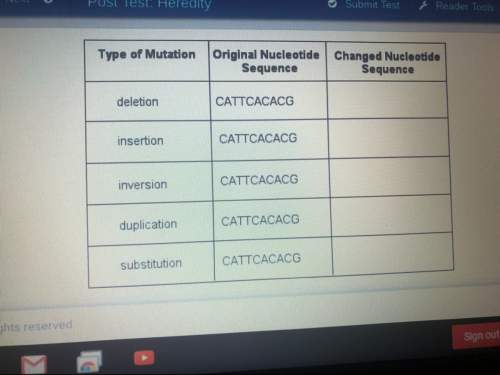
Biology, 23.04.2020 21:25, DallasPotts7018
In 1883, Theodor W. Engelmann conducted a classic experiment in which he illuminated a filament of photosynthetic algae with light that passed through a prism, thus exposing different segments of the algae to different wavelengths of light. He then added aerobic, nonphotosynthetic bacteria, and noted that the largest groups of bacteria were found in the areas illuminated by the red and blue light. Using what you know about photosynthesis and cellular respiration, which of the following would best explain the reason for the bacteria congregating in the regions with red and blue light?
a. The bacteria have a negative phototropic response to green light and move away from it toward the blue and red regions.
b. More bacteria congregated in the red and blue light regions because they could photosynthesize more rapidly using these wavelengths of light.
c. More bacteria congregated in the red and blue light regions because these wavelengths provide the most thermal energy.
d. More bacteria congregated in the red and blue light regions because the algae in those regions produced the most oxygen.

Answers: 2
Other questions on the subject: Biology

Biology, 21.06.2019 19:30, seawu
Look at the following answer choices and determine which belongs in the both category. testable, can be disproven explains natural phenomena, has evidence to support it prediction, tentative, one or more scientists working together well established, many different scientists working independently, highly reliable
Answers: 1

Biology, 22.06.2019 08:40, keilyjaramillo2870
What best explains whether bromine (br) or neon (ne) is more likely to form a covalent bond? bromine forms covalent bonds because it has seven valence electrons, but neon has eight valence electrons and already fulfills the octet rule. bromine forms covalent bonds because it has many electron shells, but neon has only two electron shells and is tightly bound to its electrons. neon forms covalent bonds because it can share its valence electrons, but bromine has seven valence electrons and can gain only one more electron. neon forms covalent bonds because it has only two electron shells, but bromine has many electron shells and will lose electrons in order to fulfill the octet rule.
Answers: 3

Biology, 22.06.2019 23:00, ashbela16
The image shows a sandstone formation with visible bands of different colors. what do the bands indicate about how this sedimentary rock was formed? choose two answers. a). the rock was made from more than one material. b). water was absent during the compaction and cementation process. c). sediments and other matter were deposited in layers before lithification. d). the rock was stretched horizontally by the pressure from surrounding rocks. e). layers of hot liquid in the rocks cooled and solidified at different tempatures
Answers: 3
Do you know the correct answer?
In 1883, Theodor W. Engelmann conducted a classic experiment in which he illuminated a filament of p...
Questions in other subjects:

Health, 13.01.2021 22:00




English, 13.01.2021 22:00

Mathematics, 13.01.2021 22:00

English, 13.01.2021 22:00


Medicine, 13.01.2021 22:00

Mathematics, 13.01.2021 22:00







